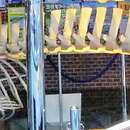en
names in breadcrumbs


Perception Channels: tactile ; chemical
These whales are a conservation concern. They are listed as Appendix II by CITES, and Data deficient by IUCN.
US Federal List: no special status
CITES: appendix ii
IUCN Red List of Threatened Species: data deficient
The meat of M. stejnegeri is considered palatable when cooked, but the Makah Indians of Washington reported cases of diarrhea after eating the blubber and flesh. Commercial fisheries, primarily in Japan, take a small number of M. stejnegeri yearly.
Positive Impacts: food
Mesoplodon stejnegeri feeds primarily on deep-water squid. The diet includes both cephalopods and fish. A school of salmon was observed being chased by M. stejnegeri off the coast of Japan, and this species is sometimes trapped in salmon driftnets.
Animal Foods: fish; mollusks
Primary Diet: carnivore (Molluscivore )
Mesoplodon stejnegeri ranges from the Bering Sea to California and Japan, inhabiting only the cool temperate waters of the Northern Pacific Ocean.
Biogeographic Regions: pacific ocean (Native )
Stejneger's beaked whales, Mesoplodon stejnegeri, inhabit the deep waters of the ocean far from the shorelines. These animals are rarely seen at sea. They prefer a habitat with cool water. Mesoplodon stejnegeri has been observed living sympatrically with Hubb's beaked whales where the ranges of the two species overlap off the coast of northern Japan to Oregon and British Columbia.
Habitat Regions: temperate ; saltwater or marine
Aquatic Biomes: pelagic
Mesoplodon stejnegeri ranges in length from 3 to 7 m, although they are generally longer than 5.3 m. Females are normally longer than males, and the crania of females are larger than those of males.
Both sexes are uniformly gray to black, with light pale countershading ventrally, although males tend to be more uniformly dark.
Mesoplodon stejnegeri is distinguished from other Mesoplodons by tooth shape and position. Members of this species have two large, exposed, tusk-like teeth on the lower jaw (Nowak 1999). These teeth are also distinctively larger in males.
Scarring, which is present on most M. stejnegeri, results from intraspecific fighting over mates, and is inflicted by the teeth while the mouth is closed (Ridgway and Harrison 1989).
Range length: 3 to 7 m.
Other Physical Features: endothermic ; homoiothermic; bilateral symmetry
Sexual Dimorphism: female larger; male more colorful; ornamentation
Nothing is known about the reproduction of M. stejnegeri, although it is speculated that litter size is one and parturition occurs in the spring and summer.
Range number of offspring: 1 (low) .
Average number of offspring: 1.
Key Reproductive Features: iteroparous ; seasonal breeding ; gonochoric/gonochoristic/dioecious (sexes separate); sexual ; fertilization ; viviparous
Although parental investment in this species has not been documented, because these animals are mammals we can infer that females provide a great deal of parental care. They are likely to provide their young with protection as well as food, in the form of milk, until the calves are able to care for themselves.
Parental Investment: pre-fertilization (Provisioning, Protecting: Female); pre-hatching/birth (Provisioning: Female, Protecting: Female); pre-weaning/fledging (Provisioning: Female, Protecting: Female); pre-independence (Protecting: Female)